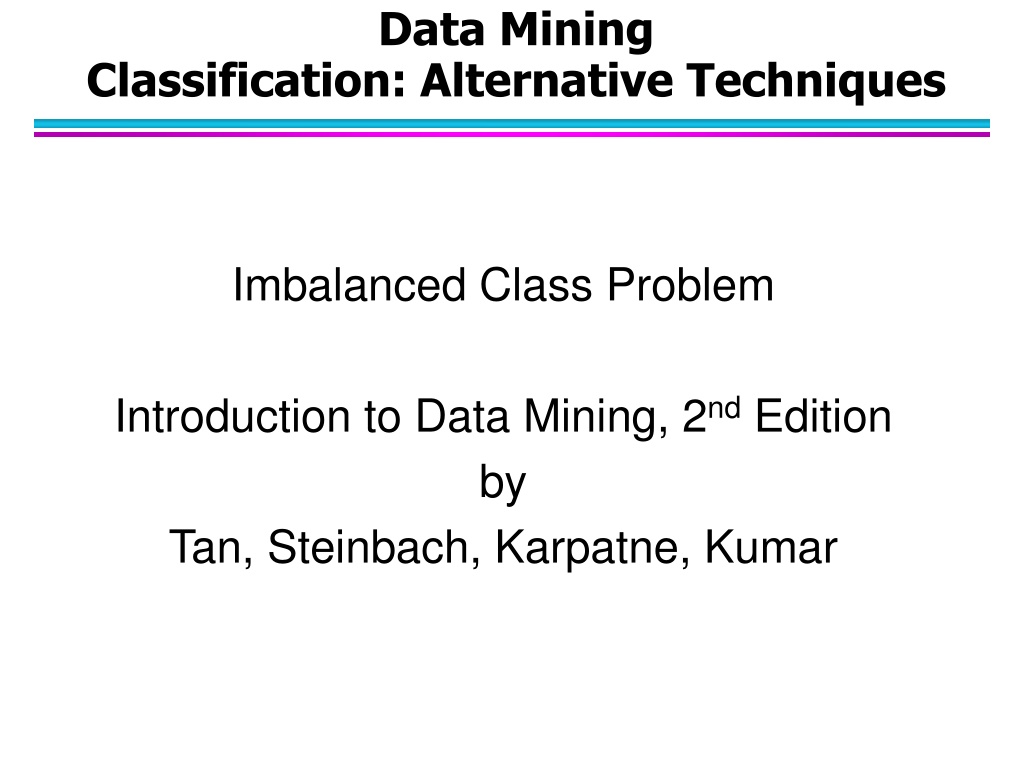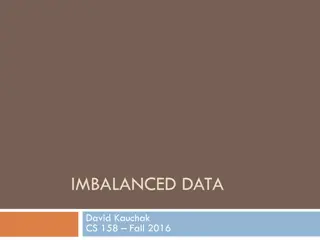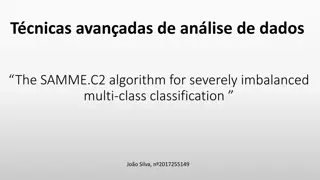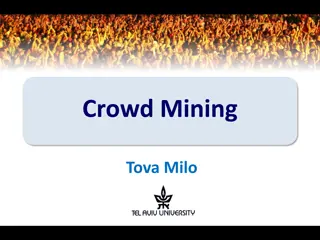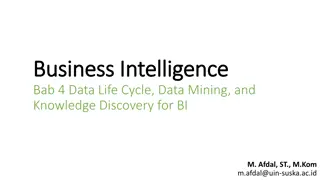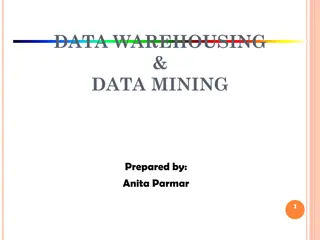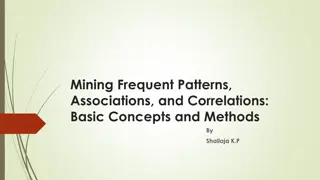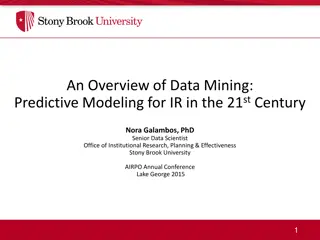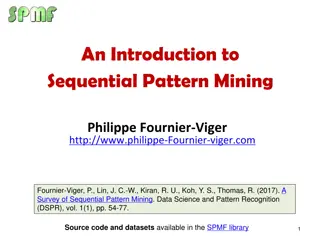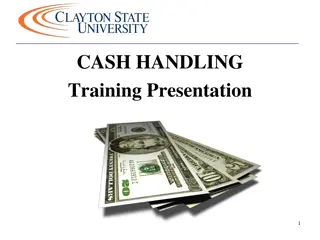Handling Imbalanced Class Problems in Data Mining
Addressing the challenges posed by imbalanced class problems in data mining is crucial for accurate classification. Class imbalance can affect evaluation measures like accuracy and requires alternative techniques such as precision, recall, and F-measure. Detecting rare classes, such as credit card fraud or defective products, necessitates specialized approaches to ensure effective analysis and decision-making.
- Imbalanced Classes
- Data Mining Techniques
- Classification Problems
- Precision-Recall
- Rare Class Detection
Download Presentation

Please find below an Image/Link to download the presentation.
The content on the website is provided AS IS for your information and personal use only. It may not be sold, licensed, or shared on other websites without obtaining consent from the author. Download presentation by click this link. If you encounter any issues during the download, it is possible that the publisher has removed the file from their server.
E N D
Presentation Transcript
Data Mining Classification: Alternative Techniques Imbalanced Class Problem Introduction to Data Mining, 2nd Edition by Tan, Steinbach, Karpatne, Kumar
Class Imbalance Problem Lots of classification problems where the classes are skewed (more records from one class than another) Credit card fraud Intrusion detection Defective products in manufacturing assembly line 02/03/2018 Introduction to Data Mining, 2nd Edition 2
Challenges Evaluation measures such as accuracy is not well-suited for imbalanced class Detecting the rare class is like finding needle in a haystack 02/03/2018 Introduction to Data Mining, 2nd Edition 3
Confusion Matrix Confusion Matrix: PREDICTED CLASS Class=Yes Class=No Class=Yes a b ACTUAL CLASS Class=No c d a: TP (true positive) b: FN (false negative) c: FP (false positive) d: TN (true negative) 02/03/2018 Introduction to Data Mining, 2nd Edition 4
Accuracy PREDICTED CLASS Class=Yes Class=No Class=Yes a b ACTUAL CLASS (TP) c (FP) (FN) d (TN) Class=No Most widely-used metric: + + a d TP TN = = Accuracy + + + + + + a b c d TP TN FP FN 02/03/2018 Introduction to Data Mining, 2nd Edition 5
Problem with Accuracy Consider a 2-class problem Number of Class 0 examples = 9990 Number of Class 1 examples = 10 02/03/2018 Introduction to Data Mining, 2nd Edition 6
Problem with Accuracy Consider a 2-class problem Number of Class NO examples = 990 Number of Class YES examples = 10 If a model predicts everything to be class NO, accuracy is 990/1000 = 99 % This is misleading because the model does not detect any class YES example Detecting the rare class is usually more interesting (e.g., frauds, intrusions, defects, etc) 02/03/2018 Introduction to Data Mining, 2nd Edition 7
Alternative Measures PREDICTED CLASS Class=Yes Class=No Class=Yes a b ACTUAL CLASS Class=No c d a + = Precision (p) a c a + = Recall (r) a b 2 2 rp + a = = F - measure (F) + + 2 r p a b c 02/03/2018 Introduction to Data Mining, 2nd Edition 8
Alternative Measures 10 + = = Precision (p) 5 . 0 PREDICTED CLASS 10 10 10 + Class=Yes Class=No = = Recall (r) 1 10 0 Class=Yes 10 0 2 * 1 5 . 0 * ACTUAL CLASS = = F - measure (F) . 0 62 5 . 0 + 1 Class=No 10 980 990 = = Accuracy . 0 99 1000 02/03/2018 Introduction to Data Mining, 2nd Edition 9
Alternative Measures 10 + = = Precision (p) 5 . 0 PREDICTED CLASS 10 10 10 + Class=Yes Class=No = = Recall (r) 1 10 0 Class=Yes 10 0 2 * 1 5 . 0 * ACTUAL CLASS = = F - measure (F) . 0 62 5 . 0 + 1 Class=No 10 980 990 = = Accuracy . 0 99 1000 1 + PREDICTED CLASS = = Precision (p) 1 1 0 Class=Yes Class=No 1 + = = Recall (r) 1 . 0 1 9 Class=Yes 1 9 ACTUAL CLASS 2 1 . 0 * * 1 = = F - measure (F) . 0 18 Class=No 0 990 1 . 0 + 1 991 = = Accuracy . 0 991 1000 02/03/2018 Introduction to Data Mining, 2nd Edition 10
Alternative Measures PREDICTED CLASS = Precision (p) = 8 . 0 Class=Yes Class=No Recall (r) 8 . 0 Class=Yes 40 10 = F - measure (F) = 8 . 0 ACTUAL CLASS Accuracy 8 . 0 Class=No 10 40 02/03/2018 Introduction to Data Mining, 2nd Edition 11
Alternative Measures PREDICTED CLASS = Precision (p) = 8 . 0 Class=Yes Class=No Recall (r) 8 . 0 Class=Yes 40 10 = F - measure (F) = 8 . 0 ACTUAL CLASS Accuracy 8 . 0 Class=No 10 40 PREDICTED CLASS Class=Yes Class=No = Precision (p) = ~ . 0 04 Recall (r) 8 . 0 Class=Yes 40 10 ACTUAL CLASS = F - measure (F) = ~ . 0 08 Class=No 1000 4000 Accuracy ~ 8 . 0 02/03/2018 Introduction to Data Mining, 2nd Edition 12
Measures of Classification Performance PREDICTED CLASS Yes No ACTUAL CLASS Yes No TP FP FN TN is the probability that we reject the null hypothesis when it is true. This is a Type I error or a false positive (FP). is the probability that we accept the null hypothesis when it is false. This is a Type II error or a false negative (FN). 02/03/2018 Introduction to Data Mining, 2nd Edition 13
Alternative Measures = Precision (p) 8 . 0 PREDICTED CLASS Recall = = TPR (r) 8 . 0 Class=Yes Class=No = FPR 2 . 0 Class=Yes 40 10 = F - measure (F) = 8 . 0 ACTUAL CLASS Accuracy 8 . 0 Class=No 10 40 PREDICTED CLASS = Precision (p) ~ . 0 = 04 Class=Yes Class=No Recall = TPR (r) 8 . 0 Class=Yes 40 10 0.2 = FPR ACTUAL CLASS = F - measure (F) = ~ . 0 08 Class=No 1000 4000 Accuracy ~ 8 . 0 02/03/2018 Introduction to Data Mining, 2nd Edition 14
Alternative Measures PREDICTED CLASS = Precision (p) 5 . 0 Class=Yes Class=No Recall = = TPR (r) 2 . 0 Class=Yes 10 40 2 . 0 = ACTUAL CLASS FPR Class=No 10 40 PREDICTED CLASS = Precision (p) 5 . 0 Class=Yes Class=No Recall = = TPR (r) 5 . 0 Class=Yes 25 25 5 . 0 = FPR ACTUAL CLASS Class=No 25 25 PREDICTED CLASS = Precision (p) 5 . 0 Class=Yes Class=No Recall = = TPR (r) 8 . 0 Class=Yes 40 10 8 . 0 = FPR ACTUAL CLASS Class=No 40 10 02/03/2018 Introduction to Data Mining, 2nd Edition 15
ROC (Receiver Operating Characteristic) A graphical approach for displaying trade-off between detection rate and false alarm rate Developed in 1950s for signal detection theory to analyze noisy signals ROC curve plots TPR against FPR Performance of a model represented as a point in an ROC curve Changing the threshold parameter of classifier changes the location of the point 02/03/2018 Introduction to Data Mining, 2nd Edition 16
ROC Curve (TPR,FPR): (0,0): declare everything to be negative class (1,1): declare everything to be positive class (1,0): ideal Diagonal line: Random guessing Below diagonal line: prediction is opposite of the true class 02/03/2018 Introduction to Data Mining, 2nd Edition 17
ROC (Receiver Operating Characteristic) To draw ROC curve, classifier must produce continuous-valued output Outputs are used to rank test records, from the most likely positive class record to the least likely positive class record Many classifiers produce only discrete outputs (i.e., predicted class) How to get continuous-valued outputs? Decision trees, rule-based classifiers, neural networks, Bayesian classifiers, k-nearest neighbors, SVM 02/03/2018 Introduction to Data Mining, 2nd Edition 18
Example: Decision Trees Decision Tree x2 < 12.63 x2 < 17.35 x1 < 13.29 Continuous-valued outputs x1 < 2.15 x1 < 6.56 x2 < 12.63 x1 < 7.24 x2 < 8.64 x2 < 17.35 x1 < 13.29 x1 < 12.11 x1 < 2.15 x2 < 1.38 x1 < 6.56 0.059 0.220 x1 < 18.88 x1 < 7.24 x2 < 8.64 0.071 0.107 x1 < 12.11 x2 < 1.38 0.727 0.164 x1 < 18.88 0.669 0.271 0.143 0.654 0 02/03/2018 Introduction to Data Mining, 2nd Edition 19
ROC Curve Example x2 < 12.63 x2 < 17.35 x1 < 13.29 x1 < 2.15 x1 < 6.56 0.059 0.220 x1 < 7.24 x2 < 8.64 0.071 0.107 x1 < 12.11 x2 < 1.38 0.727 0.164 x1 < 18.88 0.669 0.271 0.143 0.654 0 02/03/2018 Introduction to Data Mining, 2nd Edition 20
ROC Curve Example - 1-dimensional data set containing 2 classes (positive and negative) - Any points located at x > t is classified as positive At threshold t: TPR=0.5, FNR=0.5, FPR=0.12, TNR=0.88 02/03/2018 Introduction to Data Mining, 2nd Edition 21
Using ROC for Model Comparison No model consistently outperform the other M1 is better for small FPR M2 is better for large FPR Area Under the ROC curve Ideal: Area = 1 Random guess: Area = 0.5 02/03/2018 Introduction to Data Mining, 2nd Edition 22
How to Construct an ROC curve Use a classifier that produces a continuous-valued score for each instance The more likely it is for the instance to be in the + class, the higher the score Sort the instances in decreasing order according to the score Apply a threshold at each unique value of the score Count the number of TP, FP, TN, FN at each threshold TPR = TP/(TP+FN) FPR = FP/(FP + TN) Instance 1 2 3 4 5 6 7 8 9 10 Score 0.95 0.93 0.87 0.85 0.85 0.85 0.76 0.53 0.43 0.25 True Class + + - - - + - + - + 02/03/2018 Introduction to Data Mining, 2nd Edition 23
How to construct an ROC curve + - + - - - + - + + Class Threshold >= 0.25 0.43 0.53 0.76 0.85 0.85 0.85 0.87 0.93 0.95 1.00 TP 5 4 4 3 3 3 3 2 2 1 0 FP 5 5 4 4 3 2 1 1 0 0 0 TN 0 0 1 1 2 3 4 4 5 5 5 FN 0 1 1 2 2 2 2 3 3 4 5 TPR 1 0.8 0.8 0.6 0.6 0.6 0.6 0.4 0.4 0.2 0 FPR 1 1 0.8 0.8 0.6 0.4 0.2 0.2 0 0 0 ROC Curve: 02/03/2018 Introduction to Data Mining, 2nd Edition 24
Handling Class Imbalanced Problem Class-based ordering (e.g. RIPPER) Rules for rare class have higher priority Cost-sensitive classification Misclassifying rare class as majority class is more expensive than misclassifying majority as rare class Sampling-based approaches 02/03/2018 Introduction to Data Mining, 2nd Edition 25
Cost Matrix PREDICTED CLASS Class=Yes Class=No ACTUAL CLASS Class=Yes f(Yes, Yes) f(Yes,No) C(i,j): Cost of misclassifying class i example as class j Class=No f(No, Yes) f(No, No) Cost Matrix PREDICTED CLASS = Cost , ( i C ) , ( i ) j f j C(i, j) Class=Yes Class=No Class=Yes C(Yes, Yes) C(Yes, No) ACTUAL CLASS Class=No C(No, Yes) C(No, No) 02/03/2018 Introduction to Data Mining, 2nd Edition 26
Computing Cost of Classification Cost Matrix PREDICTED CLASS C(i,j) + -1 1 - ACTUAL CLASS 100 0 + - Model M1 PREDICTED CLASS Model M2 PREDICTED CLASS + - + - ACTUAL CLASS ACTUAL CLASS 150 60 40 250 250 5 45 200 + - + - Accuracy = 80% Cost = 3910 Accuracy = 90% Cost = 4255 02/03/2018 Introduction to Data Mining, 2nd Edition 27
Cost Sensitive Classification Example: Bayesian classifer Given a test record x: Compute p(i|x) for each class i Decision rule: classify node as class k if = arg max i ( | ) k p i x For 2-class, classify x as + if p(+|x) > p(-|x) This decision rule implicitly assumes that C(+|+) = C(-|-) = 0 and C(+|-) = C(-|+) 02/03/2018 Introduction to Data Mining, 2nd Edition 28
Cost Sensitive Classification General decision rule: Classify test record x as class k if i = arg min ( | ) , ( ) k p i x C i j j 2-class: Cost(+) = p(+|x) C(+,+) + p(-|x) C(-,+) Cost(-) = p(+|x) C(+,-) + p(-|x) C(-,-) Decision rule: classify x as + if Cost(+) < Cost(-) if C(+,+) = C(-,-) = 0: ( p + C ( , ) C + | ) x + + + ( , ) ( , ) C 02/03/2018 Introduction to Data Mining, 2nd Edition 29
Sampling-based Approaches Modify the distribution of training data so that rare class is well-represented in training set Undersample the majority class Oversample the rare class Advantages and disadvantages 02/03/2018 Introduction to Data Mining, 2nd Edition 30
